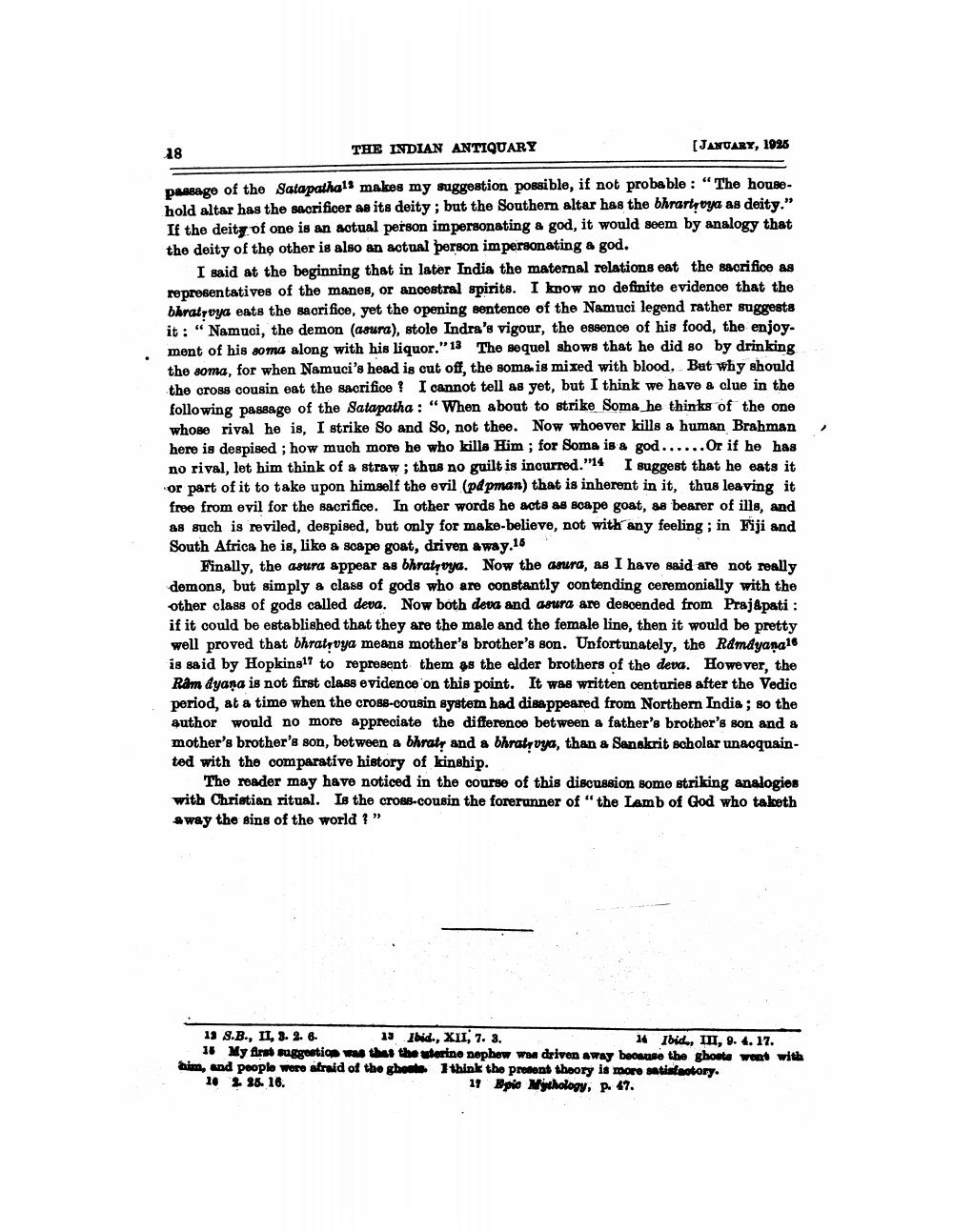________________
28
(JANUARY, 1925
THE INDIAN ANTIQUARY
passage of the Satapathal' makes my suggestion possible, if not probable : "The house. hold altar has the sacrificer as its deity; but the Southern altar has the bhrarty ya as deity." If the deity of one is an actual person impersonating a god, it would seem by analogy that the deity of the other is also an actual person impersonating a god.
I said at the beginning that in later India the maternal relations eat the sacrifice as representatives of the manes, or ancestral spirits. I know no definite evidence that the bhratīvya eats the sacrifice, yet the opening sentence of the Namuci legend rather suggests it : "Namuoi, the demon (asura), stole Indra's vigour, the essence of his food, the enjoyment of his soma along with his liquor."18 The sequel shows that he did so by drinking the soma, for when Namuci's head is cut off, the soma is mixed with blood, Bat why should the cross cousin eat the sacrifice ! I cannot tell as yet, but I think we have a clue in the following passage of the Satapatha : "When about to strike Soma he thinks of the one whose rival he is, I strike So and So, not thee. Now whoever kills a human Brahman here is despised; how much more he who kille Him; for Soma is 8 god...... Or if he has no rival, let him think of a straw; thus no guilt is incurred."14 I suggest that he eats it or part of it to take upon himself the evil (pdpman) that is inherent in it, thus leaving it free from evil for the sacrifice. In other words he acts as soape goat, as bearer of ills, and as such is reviled, despised, but only for make-believe, not with any feeling; in Fiji and South Africa he is, like & scape goat, driven away.16
Finally, the asura appear as bhratyvya. Now the asura, as I have said are not really demons, but simply a class of gods who are constantly contending ceremonially with the other class of gods called deva. Now both deva and asura are descended from Prajapati : if it could be established that they are the male and the female line, then it would be pretty well proved that bhratyvya means mother's brother's son. Unfortunately, the Ramdyana16 is said by Hopking17 to represent them as the elder brothers of the deva. However, the Ram dyana is not first class evidence on this point. It was written centuries after the Vedio period, at a time when the cross-cousin system had disappeared from Northern India ; so the author would no more appreciate the difference between a father's brother's son and a mother's brother's son, between a bhrat, and a bhralyvya, than a Sanskrit scholar unacquainted with the comparative history of kinship.
The reader may have noticed in the course of this discussion some striking analogies with Christian ritual. Is the cross-cousin the forerunner of "the Lamb of God who taketh away the sins of the world ? "
13 S.B., 11, 8.2.. 13 Ibid., XII, 7. 3.
14 Ibid., III, 9. 4. 17. 18 My first toggostio wethas the stortno nephew was driven away boonuse the ghoste went with him, and people were afraid of the ghost I think the prodont theory is more satisfactory. 16 286. 16.
11 Epic Mythology, p. 47.




